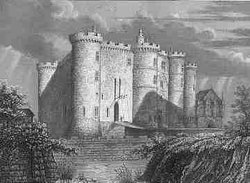Bastille
|
|
- For Bastille Linux, a hardening application, see Bastille Linux.
The Bastille was a prison in Paris, known formally as Bastille Saint-Antoine—Number 232, Rue Saint-Antoine. The storming of the Bastille on July 14, 1789 marked the beginning of the French Revolution. The event was commemorated one year later by the Fête de la Fédération. The French national holiday, celebrated annually on July 14 is officially the Fête Nationale, and officially commemorates the Fête de la Fédération, but it is commonly known in English as Bastille Day. Bastille is a French word meaning "castle" or "stronghold"; used as a single word ("la Bastille" in French), it refers to the prison.
| Contents |
Early history
Built around 1370 as part of the defenses of Paris, the structure was converted into a prison in the 17th century by Charles VI. At that time it primarily housed political prisoners, but also religious prisoners, "seditious" writers, and young rakes held at the request of their families. It began to acquire a poor reputation when it became the main prison for those taken under lettres de cachet issued by the Bourbon kings.
By the late 18th century, the building was made up of eight close-packed towers, around 24 m (80 feet) high, surrounding two courtyards and the armory. The prisoners were held within the five- to seven-story towers, each having a room around 4.6 m (15 feet) across and containing various articles of furniture. The infamous cachots—the oozing, vermin-infested subterranean cells—were no longer in use. The governor of the prison was given a daily allowance per prisoner, the amount depending on their status—from nineteen livres per diem for scientists and academics down to three for commoners. In terms of standards, there were many worse prisons in France, including the dreaded Bicêtre, also in Paris. However, in terms of popular literary accounts, the Bastille was a place of horror and oppression—a symbol of autocratic cruelty.
Storming
Main article: Storming of the Bastille.
Taking_of_the_Bastille.jpg
The confrontation between the commoners and the ancien régime ultimately led to the people of Paris storming the Bastille on July 14, 1789. At this point, the jail was near empty, with only seven inmates: four counterfeiters, two madmen, and a young aristocrat who had displeased his father. The garrison consisted of only 32 men under Governor Bernard-René de Launay.
A crowd of around 1,000 people gathered outside around mid-morning, calling for the surrender of the prison, the removal of the guns and the release of the arms and gunpowder. Two deputies were invited into the fortress and slow negotiations began.
In the early afternoon, the crowd broke into the undefended outer courtyard and the chains on the drawbridge to the inner courtyard were cut. A spasmodic exchange of gunfire began; in mid-afternoon the crowd was reinforced by gardes françaises and two cannons. De Launay ordered a ceasefire; despite his surrender demands being refused, he capitulated and the vainqueurs swept in to liberate the fortress at around 5:30.
Ninety-eight attackers and one defender had died. De Launay was seized and dragged towards the Hôtel de Ville, but was stabbed to death by the mob in the street outside the Hôtel.
Historical assessment
Many historians believe that the storming of the Bastille was more important as a rallying point and symbolic act of rebellion than any practical act of defiance. No less important in the history of France, it was not the image typically conjured up of courageous French patriots storming a towering fortress and freeing hundreds of oppressed peasants. This myth-making began on July 17 1789 with the publication of the Révolutions de Paris with a colourful description of the attack and an entirely false description of the many prisoners freed.
Famous prisoners
- Fouquet
- Voltaire
- Marquis de Sade
- Claude de Bourdeille, comte de Montrésor
- René Auguste Constantin de Renneville
- Charles de Valois, Duke of Angoulême
- Hugues Aubriot
- Comte de Rochefort (fictional)
- Louis François Armand du Plessis, duc de Richelieu
- Pierre de Cavagnal, Marquis de Vaudreuil
- Marguerite De Launay, Baronne Staal
- Giuseppe Marco Fieschi
- James Douglas, 4th Earl of Morton
- Louis Pierre Manuel
- François Henri de Montmorency-Bouteville, duc de Luxembourg
- Antoine Nompar de Caumont
- François de La Rochefoucauld
- François de Bassompierre
- André Morellet
- Jacques Pierre Brissot
- Charles François Dumouriez
- Roger de Rabutin, Comte de Bussy
- John Vanbrugh
- Doctor Alexander Manette (fictional)
Demolition
The propaganda value of the Bastille was quickly seized upon, notably by the showy entrepreneur Pierre-François Palloy, "Patriote Palloy." The fate of the Bastille was uncertain, but Palloy was quick to establish a claim, organizing a force of 500 demolition men around the site on the 15th. Over the next few days many notables visitied the Bastille and it seemed to be turning into a memorial. But Palloy secured a license for demolition from the Permanent Committee at the Hôtel de Ville and quickly took complete control.
Palloy secured a fair budget and his crew grew to around 1,000 men. Palloy had control over all aspects of the work and the workers, even to the extent of having two hanged for murders. He put much effort into continuing the site as a paying attraction and producing a huge range of souvenirs, including much of the rubble. The actual demolition proceeded apace - by November the structure was largely demolished.
PlaceBastille20040914B_CopyrightKaihsuTai.JPG
The area today
The former location of the fort is currently called the Place de la Bastille, and some of the remains (although not at their original location) are still visible nearby. The Opéra Bastille, among other buildings, is located on the Place.bg:Бастилия da:Bastillen de:Bastille es:La Bastilla fr:Bastille (Paris) he:בסטיליה ja:バスティーユ牢獄 nl:Bastille Saint-Antoine no:Bastillen pl:Bastylia pt:Bastilha fi:Bastilji sv:Bastiljen zh:巴士底狱

